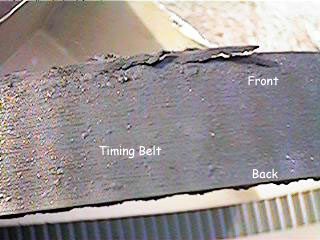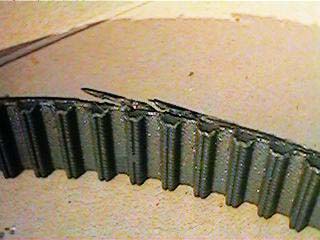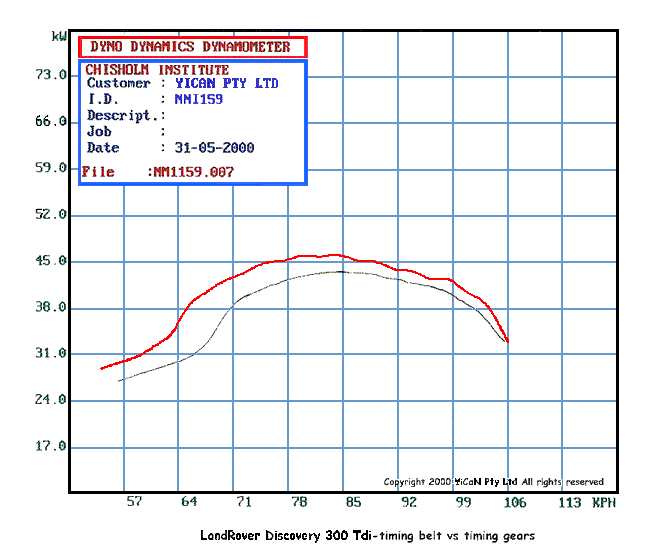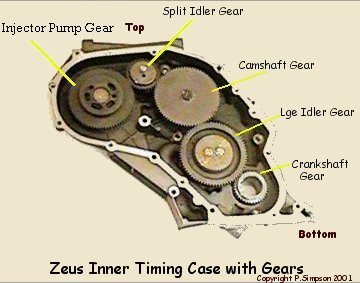Timing Belt Degradation in the 300 Tdi
Having seen timing
belts break on new vehicles with only 18000km on them, and having the 4th
fitted to my own vehicle at 104000km, I was interested to see what a belt with
3700km looked like after being fitted.
The first surprise
was found when the front timing cover was removed.

Given the problems
related to timing belts, it became a habit of checking for belt debris via the
front wading plug. As can be seen in the above picture, very little debris
comes far enough down to be “inspected” at the wading plug.

The close up view
shows that the area around the wading plug is relatively clean. A closer
examination also shows the wear in the timing case cover from previous
“migrating” belts.

This next view of
the inner timing case shows how the debris is well clear of the area around the
wading plughole. While inspecting for debris via the wading plug may make you
feel comfortable it is not a clear representation of the status of the belt.

Inner timing case,
showing collected debris. It should be noted that this is from an engine, with
a belt fitted less 4000km before this inspection. The pictures also show the
modified crankshaft gear fitted by local dealership as part of “timing belt
fix”.

The actual belt is
shown in this next photograph, and is shown prior to removal.

While not well
focussed the next picture shows the belt beginning to fray-possibly from
running against the front of the edges of the modified crankshaft gear?
The pen points to
one of three fray points on the timing belt.

Close-up views of
belt debris at an oblique angle.

The side view
shows the matted nature of the belt debris. It should be noted that this
material has stayed in this formation, after the inner timing case was removed
from the engine. This process involves separating this component from the front
of the engine after removing the belt and a number of gears.

Given that the
belt is a timing belt, one wonders what impact this debris has if it falls onto
the belt when in operation.
The author and
others have noted that the 300 Tdi has the occasional habit of small power
surges at around 2000 rpm, and this could perhaps be due to either debris
falling onto the belt (it should be remembered that both sides of the belt are
used) or movement of the belt causing changes in the injector pump timing.
Prior to removing the belt it was interesting to note the effect of any small
deflection on the belt had on the injector pump.
What’s all the fuss about belts?
If your trouser
belt breaks, not a real drama, except that you may cause yourself some
embarrassment, and or find yourself the centre of unexpected attention.
If your timing
belt breaks, then this is a real drama. Depending on where you are and what you
were doing when it breaks will determine the extent of the drama.
A broken timing
belt means your engine is inoperable.
No matter how
quickly you react to the break, and it happens quickly and quietly, you will
not prevent some engine damage by pushing in the clutch to prevent the engine
from being “driven” by the drive train. I am unaware at this stage what happens
in an automatic.
If you were
descending a steep hill, you have suddenly lost all engine braking, power
steering, and your brakes are now no longer power assisted, and it will take
longer to stop. Besides, having been trained in the correct 4WD techniques for
steep descents, you were relying on the engine, and not your brakes.
If you were
cruising down the highway, you have no power, no power steering, and your
brakes are now no longer power assisted, and it will take longer to stop.
At this point your
vehicle is disabled and you will need to either be towed (and this can be
strenuous work for the driver as the power steering and power assisted brakes
no longer work) or have the vehicle taken to the nearest garage by flat top
truck. There is nothing you can do, even if you had a spare timing belt, all
the tools and 4-5 hours to fix the problem.
So what happens when the timing belt breaks?
This is classic
question that prompts the asking of another classic question; “How long is a
piece of string?”
The answer lies in
an understanding of the function of the timing belt, and will vary at the time
it breaks, the engine rpm etc.
The timing belt is
responsible for ensuring that the pistons, injector pump, inlet and exhaust
valves are in the correct place of the 4-stroke cycle at the appropriate time.
If not there is a real risk of collisions between these components, and as this
is outside the purposes for which they were intended, they and other parts of
the engine will be damaged.
The extent of the
damage is difficult to predict, and will only be known once the garage has
inspected the engine.
If you were lucky
the damage may be restricted to belt breaking, and as a result only the push
rods were damaged. These appear to have the amazing ability to bend almost in
an extended “s” shape.
If we were to
simply replace the push rods and timing belt, and remove the head to ensure
that none of the valves had collided with any of the pistons, we would have a
shopping list something like this:
Timing belt $165.68
Push rods 8 x $15.96 $127.68
Head Gasket $82.52
Subtotal $375.88
Oil $60.00
Oil filter $22.45
Parts and consumables $458.33
To this we now add
labour costs, and for this exercise we’ll allow 5 hours. Depending where the
work is carried out i.e. dealer or independent service agent this will add
between $250 - $375.
No allowance has
been made for transportation costs back to the point of service, as this will
depend upon the location, and wether or not you have some form of auto club
insurance to cover this recovery.
This gives a cost of
between $708 and $833 for a “good break”. In the case of experiencing more
damage both labour and parts costs will be much higher.
Can’t I simply change the belt on a preventative manner?
Yes you can, but
this will cost between $360 - $460 depending on where the work is done. The
original replacement period has been changed from 100,000 km to a range
somewhere between 60,000 km and 100,000 km depending on how the vehicle is
used.
Changing the belt,
or even fitting the upgrade kits, doesn’t give an absolute guarantee that it
won’t fail prematurely. The photos above are from a belt that was changed by a
local dealer, and has done less than 4000 km, and was fitted with all the
manufacturers’ timing belt modifications.
Can I have another look at that belt?
Here are some
shots taken after the belt was removed from the engine. You can now get a
clearer picture of the shredding process as it starts. Remember this is a belt
with 3700 km of use.

Here is a view
from a different angle.

It was also interesting
to see the manner in which the injector pump sprocket collects the belt debris.
A cynic might ask if this was design foresight or simply good luck!

Anyone who has
worked at a side show may think this is a photo of one of the machines used to
make candy floss (aka fairy floss).
OK, so let me guess, you just happen to have the solution?
Indirectly, yes I
do. I have been investigating this problem for a while, as I like my 300 Tdi Discovery.
I recognise it has some interesting quirks, but with the exception of the
timing belt problem, none of these would be as disabling or expensive.
I don’t want to
upgrade to the new model, and I am a committed Land Rover user, and wouldn’t
consider any of the other manufacturers. As I plan to keep my “disco” for quite
some time I was determined to find a solution, based on good engineering, and
accessible to the general public. I also wanted something that I could fit
myself.
The solution was
found in England, in the form of the timing gears from Zeus. I researched their
product extensively, and as a result have taken responsibility for offering
these products in Australia and New Zealand. I have fitted the gears to my car,
and the data from the pre and post installation dynometer studies are shown below.
You remind me of the advertisement for a certain
electric shaver.
Understandable
comparison, but there are differences.
That gentleman was
so impressed he bought the company, as he had the obvious ability to do so.
While I don’t have
his extensive resources, I am putting my money where my mouth is, and will be
selling and supporting the products in this market.
I accept that the gears work, but I don’t have the
time to fit them.
YiCaN Pty Ltd
recognise that not everyone will want to fit his or her own gears for a number
of reasons. There are some special tools required, but even these, can be made
by the vehicles owner. Therefore in anticipation of this situation, approved
fitment centres are being established, by cooperating with local companies with
4WD and diesel experience. We are starting in Melbourne, where we are based,
and will cover other cities and regions in an orderly manner.
For those people
wanting to fit their own gears, step-by-step instructions are available, and
the special tools may be made available for hire to Australian customers.
What did you find in the dynometer studies?
Rather than describe what we found let me show you the results. The graph confirms, and quantifies, the increase in power at the low end. What was surprising was the size of this increase-nearly 10 kW at around 65kmh.
As expected the extra power increase translates into improvements in fuel economy. Typically we are finding an extra 150 km range is added to each tank of diesel. The best range so far in the Discovery, with a mixture of town and highway driving is 909 km from one tank!

In both tests the engine was "tuned" with the engine being set to TDC and the injector pump timing set at this point. This is the standard method of adjusting the 300Tdi engine. The injector pump was not altered in any way, and is as per standard settings for this pump. The dynometer test was carried out by the Chisholm Institute, Frankston, and the same operator carried out both tests. As such we believe this to be an independent test as it was totally under his control, including the "driving" of the vehicle on the dynometer.
It should be noted that the objective of fitting the Zeus Timing Gears was to eliminate timing belt problems and associated damage-changes to performance are simply a bonus.
Sounds good, but what do I get in a kit?
Here is a photo of the Zeus Timing Gear kit as seen from the front. This shows the system prior to the installation of the original front timing cover.
In addition to the parts shown here the kit includes: gaskets, wading plug, instructions, warning sticker, oil banjo plug, permabond, warranty form, dowels and studs. Basically, everything you need except for
oil and your own tools, to fit the kit.

The kit is shipped to you in a strengthened cardboard box, weighing about 11.0 kg. Method of delivery is usually by
Express Parcel Post within Australia, or international courier eg FED-EX for our International customers. If you have a prefered method of shipment
this can be used if required.
How do I find out more about the Zeus Gears and your company services?
Listed below are our email, fax and phone numbers, so please use whichever is the most convenient for you.